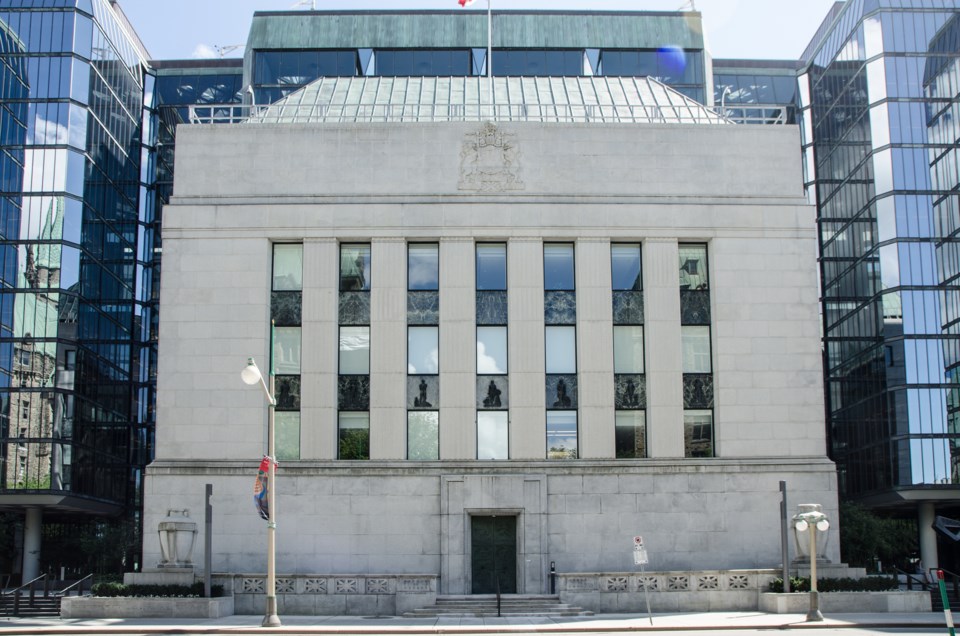The Bank of sa国际传媒 may be ready to trim much more fat from its overnight rate this week than previously expected, according to one economist.
The central bank is set to announce its decision on the target for the overnight rate Wednesday (Oct. 23). It currently stands at 4.25 per cent.
While two-thirds of economists polled by Reuters last week expect a reduction of 50 basis points, or 0.5 percentage points, there might be a reasonable argument to be made in favour of a 75-basis-point cut at tomorrow’s announcement in Ottawa.
In an Oct. 18 note to investors, Avery Shenfeld, managing director and chief economist with Canadian Imperial Bank of Commerce (TSX: CM), said the central bank often shifts its overnight rate in increments of 25 or 50 basis points, but that a 75-basis-point drop is not totally out of the question.
“While a mega-move isn’t our base-case forecast, there are reasons to think that governor [Tiff] Macklem’s team will give such a move more consideration than the 25-basis-point cut that some economists are still projecting,” Shenfeld wrote.
He said many economists expect an easing of 75 basis points by December, so the central bank could potentially leap there tomorrow if it’s going to happen anyway.
“If a 3.5-per-cent or lower overnight rate is appropriate for three months from now, it’s hard to see why it wouldn’t be even better to get there sooner, in order to shorten the wait for its impacts to kick in,” Shenfeld wrote.
“That sort of front-loading was what the [Bank of sa国际传媒] did when it hiked rates by 100 basis points in a single step during the most recent tightening cycle. The bank was sure that it would need at least that much tightening to address inflation risks, and getting those conditions in place sooner was appropriate. With inflation now running below the two-per-cent target, particularly in measures that exclude mortgage interest costs, and economic growth still subdued, the same argument could be made in reverse.”
So far this year, the Bank of sa国际传媒 has cut its overnight lending rate three times, in 25-basis-point increments, going from five per cent to 4.25 per cent, where the rate stood for about a year between June 2023 and June 2024.
Before that, there was a rapid tightening in rates, in a very short window, from a low of 0.25 per cent in early 2022 to the five-per-cent peak in June 2023. Prior to July 2022, the policy rate had been under two per cent since December 2008, when a global financial crisis was in full swing.
In his note to investors, Shenfeld wrote that the Bank of sa国际传媒’s decisions will depend in large part on the economic outlook in the U.S., sa国际传媒’s largest trading partner. With interwoven economies, and with the U.S. currently experiencing a relatively stronger (and hence more inflationary) economy, the U.S. Federal Reserve could dial back its own rate cuts.
Meantime, TD Bank (TSX:TD) chief economist Beata Caranci said she’s “willing to eat crow” on the Bank of sa国际传媒’s upcoming decision.
“I find myself in an unusual position of advocating for a 25-basis point reduction in the Bank of sa国际传媒 policy rate come Wednesday, when all bank peers have moved into the 50-basis point camp,” she said in an Oct. 21 note. “When the Bloomberg poll was conducted in early September, not a single hand was up for 50 basis points.”
She said the shift in consensus came after the latest inflation figures came in at 1.6 per cent earlier this month – lower than the 1.8 per cent previously forecast.
This miss was attributed to a deeper drop in gas prices.
“Energy prices collapsed as OPEC+ announced production increases that would move global supply into modest surplus position by early 2025,” Caranci said. “However, this doesn’t hit the mark for a central bank to hasten rate cuts after setting a quarter-point pace at the previous three meetings.”
Rate cuts are inflationary because they reduce the cost of money, encouraging more spending and thereby putting upward pressure on prices for goods and services.
If the Canadian and American central banks stray too far apart, there will be ripples in foreign exchange (FX) markets.
“A faster pace of easing in sa国际传媒 will set off more material weakness in the loonie, since a 50-basis-point cut is priced into the exchange rate, but a larger move is not,” Shenfeld wrote.
“Sure, there’s a benefit to a softer exchange rate as a spur to export growth, and as a cushion against a greater-than-desired drop in inflation. But a more volatile FX market makes it tougher for the bank to calibrate how much of an easing in monetary conditions it needs to deliver through its interest rate tool.”
The overnight rate is the benchmark cost of borrowing set by sa国际传媒’s central bank. From a consumer perspective, the overnight rate influences the interest rates charged on credit cards, mortgages, car loans and lines of credit.
